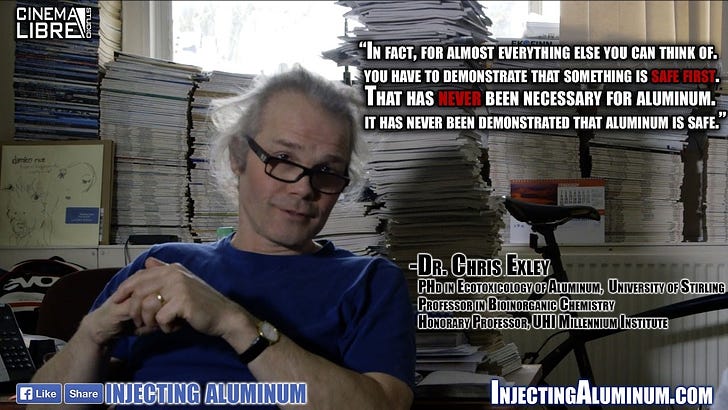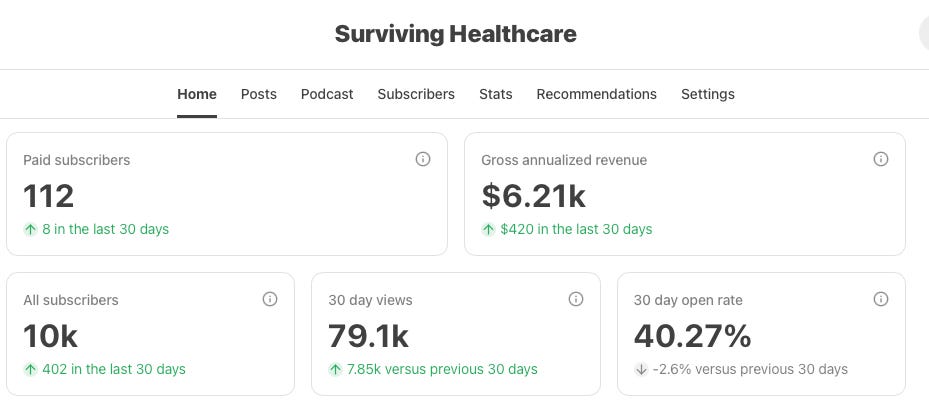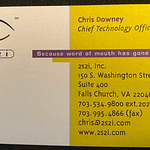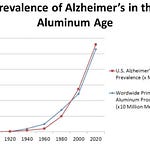Yoho note: Mercury—an even more harmful metal than aluminum—was finally removed from most vaccines in 2001, and aluminum was substituted. The vaccination industry uses these as "adjuvants," substances used to boost or stir up the immune response to a vaccine. Despite robust science establishing their harms, these metals were given litigation exemption.
The aluminum industry never funds toxicity studies. Worse, they aggressively attack critics. To conceal what they are doing to us, the Pharma companies have de-financed Exley, smeared his reputation, and lied about the science. Online searches for aluminum injury turn up a sack of paid shills claiming the metal is safe.
The YouTube videos at the end of this post are the least technical way to understand Exley’s messages. He looks like a scientist from a movie and is lovely to watch.
Surviving in the Aluminum Age
APRIL 24, 2019 BY CHRISTOPHER EXLEY, PHD, FRSB
This article appeared in Wise Traditions in Food, Farming and the Healing Arts, the quarterly journal of the Weston A. Price Foundation, Spring 2019.
We are living in the Aluminum Age.1 In our school lessons on human history, we learned all about the Iron Age and the Bronze Age, but will schoolchildren in the future be taught about the Aluminum Age? I use this term to describe the period from the late nineteenth century—when we discovered how to make aluminum metal and its salts cheaply and efficiently—until the present day, when myriad aluminum-containing products pervade every aspect of our lives.
The advent of the Aluminum Age heralded the modern world we know today. Aluminum is a feature of our food, our drinks, our medicines, our cosmetics and our environment. So, in a “Gordon Gekko” sort of way, we might say that aluminum (like greed) is good! However, our expectation with all “good things,” including those containing aluminum, is that they also be safe—at least, as they say, when exposed “in moderation.”
We have been brought up to believe in authority and to respect the opinions of experts and expert committees. In turn, we expect learned bodies and societies to be committed to our well-being. All of these values may be evident for other facets of modern life, but they do not apply to, nor have they been applied to, human exposure to aluminum.2 Many will be incredulous to learn that in the Aluminum Age, there are no health-based standards or regulations relating to human exposure to aluminum. Nor are there laws protecting us from aluminum in the air we breathe, the water we drink, the food we eat, the cosmetics we use, the medicines we need, the supplements we take or—I could go on. Aluminum is everywhere, and the result of living in the Aluminum Age is that every one of the cells that make up our body includes at least a few atoms of aluminum.
BODY BURDEN
Why should we be concerned that we are accumulating aluminum in our bodies as we age? The answer is that while the aluminum industry has long perpetuated the myth that aluminum is benign, nontoxic and even safe, nothing could be further from the truth.
In fact, there are few more biologically reactive metals than aluminum. The biologically reactive form of aluminum is its free metal ion, known as Al”3+(aq). Aluminum is bound strongly by oxygen-based functional groups in biochemistry; one example would be the phosphate groups in ATP—the energy currency of our body. Essentially, aluminum (as Al”3+(aq)) is so reactive that we expend energy simply coping with its presence in our body. If there wasn’t any aluminum in our body, all of us would have so much more natural energy.
ALUMINUM AND THE BRAIN
If feeling a little more tired than usual was the only repercussion from our body burden of aluminum, we might tolerate this state of affairs in exchange for all of the advantages of modernity brought about by the Aluminum Age. However, what happens to our brain cells and our neurons, which are struggling to cope with burgeoning amounts of aluminum? I have written elsewhere about neurons’ role as the longest-lived cells of the human body; with their biochemical advantages, neurons can be viewed as “an ostensibly immortal cell line” that has enabled human beings to live longer.3 Unfortunately, the lifespan of neurons also predisposes them to a lifetime accumulation of aluminum. With constant exposure to aluminum, can we tolerate the early loss (death) of this important immortal cell line?
When aluminum loads exceed the body’s excretory capacity, they form deposits and accumulate in tissues. In Alzheimer’s disease, aluminum accumulates in brain tissue to an extent that the brain’s coping mechanisms begin to fail. Think of your brain aluminum burden (while you still can) as a catalyst of the aging process that is bringing about age-related and eventually catastrophic changes in brain chemistry, well ahead of what should be your normal longevity.4 At a time when we are all living longer, and some dream of living forever, it is noticeable that advancing age is not ushering in better health. We may be living longer—but we are living unwell. In the Aluminum Age, it would seem all but futile to aspire to a healthy older age.
NUMBER-ONE THREAT
I have highlighted the role of aluminum in Alzheimer’s disease, but aluminum is everywhere throughout the body and is more than capable of contributing to most chronic diseases, including diabetes, autoimmunity, multiple sclerosis and other neurological conditions. To many, it seems fanciful to suggest that human exposure to aluminum is the number-one threat to human health in the twenty-first century, but thirty-five years of thinking about and researching aluminum at the highest level tell me otherwise.5
ALUMINUM AND AUTISM
Ordinarily, I am somewhat of a skeptic when I am alerted to new health issues purportedly associated with human exposure to aluminum. One recent example would be aluminum and autism. While various studies suggested a link between aluminum and autism—primarily via the aluminum adjuvants in vaccines—at first, I could not easily see a biological mechanism to support such a link. We knew that the accumulation of aluminum in brain tissue toward a toxic threshold occurred over a period of decades, so how might this relate to autism in infants? We had to test this link. We did so by obtaining brain tissues from individuals who had died with a diagnosis of autism. We then measured how much aluminum was in the brain and, significantly, where any aluminum was located in the brain.
The rest, as they say, is history. To summarize, we found extraordinarily high amounts of aluminum in autism brain tissue, and we made the unique observation that the aluminum was associated with a variety of inflammatory (non-neuronal) cells originating both in the brain (for example, the microglia) and outside of the brain (such as lymphocytes).6 The latter provided a mechanism to link aluminum adjuvants to the rapid accumulation of aluminum in brain tissue and, potentially, to autism. Our data—hard science—on aluminum and autism changed my mind; I now had to consider that aluminum could play a role in autism and that aluminum administered as adjuvants in vaccines could be a significant contributing factor.7 I am now, apparently, an “anti-vaxxer,” as they say—simply for following the science.
PRECAUTION NEEDED
The science that links human exposure to aluminum with disease is now stronger and more robust than at any other time in history. Perhaps this is why research funding for this science is now rarer than the proverbial hen’s teeth. (Do we, by chance, have industry and governments running scared of the science?) Our group is dependent upon philanthropy to continue our research. (If there are any philanthropists reading this and interested in possibly contributing to our research, please get in touch by email [in bio].)
Until the epiphany comes—when all begin to agree that we have been horribly complacent about human exposure to aluminum—we need to adopt a precautionary approach in trying to protect ourselves against the potential ravages of aluminum. I do this in part by avoiding almost all processed foods and drinks, but mainly I use our most important scientific contribution to date. In brief, that contribution is that silicon is the Earth’s natural antidote to aluminum.
Our research includes clinical trials involving healthy volunteers, individuals with Alzheimer’s disease and people with multiple sclerosis.8 These trials have shown that silicon-rich mineral water facilitates the removal of aluminum from the body in the urine. You drink the mineral water, and you pee aluminum. It is that simple, and it is completely safe. Every day, I try to drink at least one liter of a silicon-rich mineral water—that is, a mineral water where the stated content of silicon (as “silica” on the bottle) is above thirty milligrams per liter (ppm).
Do not think of this as a one-off “detox” program, however. It is a philosophy for living in the Aluminum Age and for giving yourself the best possible protection against the toxicity of aluminum—protection that no government or other body is likely to afford you in the near future.
This is not an advertisement. I do not receive any financial support from any silicon-rich mineral water company, although one company based in Malaysia does provide us with mineral water free of charge for our clinical studies (and we are thankful for that small mercy).
Note, also, that there is no silicon or silica supplement that can achieve the same benefits as silicon-rich mineral water.9 If there were a pill that could achieve the same effects, I would be the first both to use and recommend it. I do want everyone to do everything that they can to protect themselves against what I believe are the inevitable consequences of living in the Aluminum Age, namely, acute and chronic human disease. I do not really want to be around to tell you, “I told you so!”
SIDEBARS
ALUMINUM AND SILICON
As described in an eBook by the Children’s Medical Safety Research Institute (CMSRI),9 aluminum is the third most abundant element in the earth’s crust and the most abundant metal. However, having remained isolated from biological life for most of geological history, aluminum has no biological function. The situation changed with the onset of the Industrial Revolution, which released aluminum via acid rain from its inert geological stores into bays, lakes and ponds, causing irreparable damage to ecosystems.10
Studies of acid rain’s effects on biological life have shown that the earth also possesses a natural remedy for aluminum toxicity: silicon. Silicon is the second most abundant element in the earth’s crust (oxygen being the first). Silicon molecules are able to bind with aluminum ions and render them innocuous, explaining why locations subject to acid rain that are naturally silicon-rich are able to withstand the effects. This has been confirmed in studies measuring aluminum toxicity to fish in waters with various levels of silicon present.11 Silicon—a natural, plentiful element—could hold the answer to combatting the dangers brought about by the Aluminum Age.
SOURCE: Children’s Medical Safety Research Institute.
ALUMINUM ADJUVANTS AND AUTOIMMUNITY
The United States leads the world in the number of vaccines administered to pregnant women, children and adolescents—and many of the vaccines contain aluminum salts used as adjuvants. Scientists bundle vaccines with various adjuvants to increase and achieve “qualitative alteration” of the immune response to certain types of vaccines.12 A group of aluminum researchers at the University of British Columbia has pointed out, however, that “the same mechanisms that drive the immune-stimulatory effects of adjuvants have the capacity to provoke a variety of autoimmune and/or inflammatory adverse reactions.”13
Researchers have begun zeroing in on the unique risks associated with aluminum adjuvant injection. In 2011, distinguished Israeli immunologist Yehuda Schoenfeld and colleagues proposed the term “autoimmune/inflammatory syndrome induced by adjuvants” (ASIA) to capture reports of unusual immune-mediated diseases in both humans and animals, which were arising, in many instances, after injection with aluminum-containing vaccines.14 (Cases of siliconosis—illness following silicone gel injection or implants—also fall under the umbrella of ASIA.)
ASIA shows up as “vague and sundry symptoms—chronic fatigue, muscle and joint pain, sleep disturbances, cognitive impairment, skin rashes and more.”15 One of the more extensively documented manifestations of ASIA is a condition called macrophagic myofasciitis (MMF), compellingly described in the 2017 French film, Injecting Aluminum.16 As far back as the early 1990s, French neurologists started encountering patients with what was initially a mysterious ailment; over time, and after repeatedly documenting unusual aluminum deposits in the patients’ deltoid muscles, they ascertained that injected aluminum adjuvant from vaccines was not only remaining in the muscle but was migrating to and building up in distant sites such as the brain. At a 2018 conference, one of the French researchers discussed this dangerous biopersistence, stating: “It accumulates, and the more you put in the system, the more you have. When you inject aluminum, you inject it directly into the immune system.”15 The researcher also noted that a person would have to eat “one million-fold higher aluminum to get the same level of aluminum adjuvant at the level of the immune cells.”
Since 2014, individuals suffering from MMF or other manifestations of ASIA have been able to report their clinical symptoms to an international registry intended to facilitate greater understanding of the syndrome.17 In 2018, Professor Schoenfeld and others published a description of three hundred cases reported to the registry.18 They found that, on average, autoimmune conditions developed about seventeen months after adjuvant exposure, with a range of three days to five years. Although chronic fatigue and muscle and joint pain were the most commonly reported symptoms, nine in ten patients also had another diagnosed rheumatic or autoimmune condition.18
SOURCE: Children’s Medical Safety Research Institute.
WHICH VACCINES AND WHICH ALUMINUM COMPOUNDS?
U.S. vaccines containing one or more types of aluminum compounds include the following:19
All of the diphtheria, tetanus and pertussis vaccines (DT, DTaP, Td, Tdap and combination vaccines with a DTaP component);
The Haemophilus influenzae type b (Hib) vaccine;
Hepatitis A and B and the hepatitis A/B combination vaccines;
The meningococcal and pneumococcal vaccines;
Human papillomavirus (HPV) vaccines—the newest HPV vaccine (Gardasil-9) contains more than double the amount of aluminum as the original Gardasil vaccine.
Aluminum compounds in vaccines include aluminum hydroxide, aluminum phosphate, “aluminum salts,” amorphous aluminum hydroxyphosphate sulfate (AAHS) and potassium aluminum sulfate.19 Merck’s proprietary AAHS—a “super-powered” adjuvant featured in the Gardasil, Hib and hepatitis A and B vaccines—has never been safety tested (either by government regulators or Merck) and is one of the components blamed for the massive number of serious autoimmune events associated with Gardasil.20 The amount of aluminum injected into babies via multiple vaccinations exceeds anything that can be considered safe.
Amount of aluminum in the eight doses at the two-month baby checkup: 1,225 mcg21
Amount of aluminum injected into fully-vaccinated babies by 18 months of age: 4,925 mcg21
Maximum allowable aluminum per day for intravenous parenteral feeding: 25 mcg22
SOURCE: Children’s Medical Safety Research Institute.
CANNABIS AND ALUMINUM
A few years ago, a medical doctor blogging for a pro-medical marijuana website in Europe reported some “rather unsettling information” that the author described as “so disturbing that it stands to redefine medical cannabis use, and its implications in treating diseases.”23 The “unsettling” discovery had to do with research by Professor Exley showing that modern cannabis contains high levels of biologically available aluminum.
In a 2006 study of both tobacco and cannabis, Exley and colleagues observed that both “active and passive smoking… will increase the body burden of aluminum.”24 Doing some calculations, the blogger reached the astonishing conclusion that “the average one joint-per-day smoker may be absorbing as much as 3,700 micrograms of aluminum per joint into his or her pulmonary circuit,” representing “a significant risk factor for neurodegeneration.”
Where does the aluminum in cannabis come from? In an interview with the doctor/blogger, Professor Exley hypothesized that it comes “both from the soil where it is grown and also that the ‛processing’ of cannabis for recreational use may also result in its contamination” by aluminum. Exley agreed with the doctor that medical marijuana users should be concerned “because no one is checking the [aluminum] content of cannabis before it is smoked or used for medical conditions.” Exley also speculated that “long-term cannabis use may predispose to chronic diseases such as Alzheimer’s disease.”
SOURCE: medicalmarijuana.eu/harmful-levels-aluminum-cannabis-plants/.
REDUCING ALUMINUM EXPOSURE
The dramatic increase in aluminum use in consumer and industrial products means that everyone is exposed to more aluminum than at any other point in human history. It is estimated that by 2050, the amount of aluminum to which humans are exposed will have increased by 100 percent since 1950.9 Yet, despite the clear dangers aluminum poses to the environment, wildlife and humanity, the Aluminum Age shows no signs of slowing down.
The Children’s Medical Safety Research Institute recommends ten actions to protect yourself against a toxin that is “rapidly contaminating the globe from the inside out”:9
DRINK SILICON-RICH MINERAL WATERS
These have been shown to facilitate the removal of aluminum from the body. Fiji and Volvic brand bottled waters are rich sources of silicon.
AVOID OR SPACE OUT INJECTIONS OF VACCINES THAT CONTAIN ALUMINUM.
Aluminum adjuvants in vaccines can cross the blood-brain barrier, and research has confirmed links to autoimmune diseases in susceptible individuals.
DO NOT USE ALUMINUM PANS FOR COOKING.
Good alternatives include glass dishes and covers for baking, stoneware for cookie sheets and cast iron for stove-top cooking.
AVOID ALUMINUM FOIL FOR COOKING.
Aluminum has been shown to leach from foil, particularly when cooking highly acidic foods.
ONLY USE ALUMINUM-FREE NATURAL DEODORANTS.
Avoid aluminum compounds like aluminum chloride, which alters sweat-producing cells, and aluminum zirconium octachlorohydrex, which obstructs pores in the skin to prevent sweat from leaving the body.
DO NOT CONSUME DRINKS THAT CONTAIN DYES (E.G., COLORED SPORTS DRINKS).
Dyes contain aluminum compounds called “color lakes,” which contain metal salts such as aluminum.
AVOID SKIN CARE PRODUCTS WITH EMOLLIENTS CONTAINING MAGNESIUM ALUMINUM SILICATE; ALUMINUM TRISTEARATE; OR ALUMINUM STEARATE.
Aluminum tristearate is a thickening agent that prevents liquid makeup from separating or becoming runny; aluminum stearate is a colorant and emulsifier in cosmetics.
AVOID STORE-BOUGHT INFANT FORMULAS, ALL OF WHICH CONTAIN ALUMINUM.
See the Weston A. Price Foundation homemade, aluminum-free recipe for a much healthier and safer formula.25
AVOID ANTACIDS THAT CONTAIN ALUMINUM COMPOUNDS.
To reduce heartburn, try replacing chalky aluminum-containing antacid tablets with apple cider vinegar diluted in water.
LOOK FOR ALUMINUM-FREE ALTERNATIVES FOR ALL PERSONAL CARE PRODUCTS.
Make sure that hair care products, toothpastes, body soaps, sunscreens, nail polishes and buffered aspirins are aluminum-free.
SOURCE: Children’s Medical Safety Research Institute.
(For Dr. Exley’s 25 references, see the original linked in the title at the top of this post.)
A few pearls from Arnie at Liar’s World Substack
Fluoride is used to process aluminum. The aluminum industry bribed the ADA in the 1930s to ignore it. Aluminum is also used as a "flocculent" or particle aggregator in many water systems, leading to fluoride and aluminum in our drinking water.
Follow the money. For example, top fluoride emitters such as the Aluminum Company of America (ALCOA) funded the University of Cincinnati's Kettering laboratory. The lab soon became the leader in fluoride safety research. It produced a series of studies that aluminum was harmless.
The following are quotes from Dr. Russell Blaylock. He also has YouTube videos about aluminum HERE and HERE.
We know that both fluoride and aluminum, individually, are brain toxins, but when combined, as we see in fluoridated water, the mix constitutes an extremely powerful brain toxin, destroying numerous neurons in the part of the brain associated with memory and emotional functions.
It is rare for government agencies to test potentially toxic chemicals or even food additives in combination, despite extensive scientific studies showing toxic synergy for many such compounds.
Dr. Blaylock discusses chelators that are used to remove bodily aluminum:
A chelator is a substance used to remove excess metal from the body. The traditional pharmaceutical treatment for aluminum overload is desferrioxamine, a chelator that is administered either intramuscularly or via IV. Unfortunately, this can cause painful swelling at the site of the injection and has a number of serious side effects. A newer agent, called Feralex‑G, appears to be superior and can be taken orally. Recent studies have shown that, unlike most other aluminum chelators, Feralex-G can remove aluminum that has bound to the cell nucleus. (Aluminum tightly binds to the nucleic acid of DNA; this causes much of its toxicity.) Combining vitamin C with Feralex-G significantly improves the removal of aluminum from the cell nucleus, a process called shuttle chelation.
HERE is a 2004 source that discusses the best chelators for aluminum.
References
A few Exley videos follow. Listen at 2x speed.
The following is how silica-rich water likely prevents and has possibly improved several neurological diseases. Although Exley sells the stuff like he is an investor, I could not find significant conflicts of interest. He says Fiji water gave them free water for experiments, but that is the extent of their relationship.
Exley’s 2013 paper, Human exposure to aluminium.
University Shuts Down World-Renowned Aluminum Expert’s Research After Big Pharma Sets Up Shop on Campus This is a 2021 CHD article about how Exley’s research was financially “cancelled.”
Parting shot #1. Substack factoids
About two percent of all Substack readers ultimately convert to paid. As you see below, I am at 1.1 percent, which is fine. If you read somewhere that a blog has ten percent paid, something unusual and likely fraudulent is happening.
I don’t beg my subscribers for money. I beg them to sign up more readers, which will further our goals and hopefully have a multiplication effect. Thanks ahead of time for joining the revolution and continuing to read my purple prose.
#2. According to Reinette Senum, Simone Gold is a liar.
I try not to call people like this out because it diverts energy from more productive projects. And dividing and conquering us seems to be a globalist strategy. But I must have given Gold $600, so I feel betrayed.
Be careful about people who have paid platforms and those who are always crying for dollars. What are their motivations? I hope that not asking for money gives my messages credibility.














Share this post